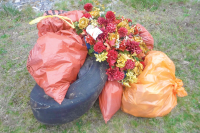How would being a town help Cullowhee?
In hopes of transforming Cullowhee into a more vibrant college community, a group dedicated to reinventing the lackluster area around campus wants the Village of Forest Hills to expand its town limits and annex a portion of the university and its surrounds.
The restaurants, coffee shops and bars typically found around universities are markedly absent at Western— witnessed by a standing joke on campus that “Cullowhee is a state of mind.”
One barrier to revitalization in Cullowhee is the lack of legal alcohol sales. Alcohol sales, from a six-pack at a gas station to a glass of wine with dinner, aren’t allowed by the county. Incorporated towns have the option of allowing alcohol sales, however, as do Sylva and Dillsboro.
If the annexation goes through, and if the Village of Forest Hills in turn passed a law to allow alcohol sales, it would help attract restaurants and a grocery store.
But there are other ways incorporation might benefit Cullowhee revitalization. Lacking town designation, the community is missing out on state and federal grants, from funding for sidewalks to sewer lines. If incorporated, the area would also be entitled to a cut sales tax revenue collected by merchants in the town limits.
Another option, and one that remains if the Village of Forest Hills decides not to expand, is for Cullowhee to incorporate as brand-new town of its own. But the process would be more arduous and complicated.
Tiny town of Forest Hills holds fate of Cullowhee revitalization in its hands
Being the top leader of the Village of Forest Hills isn’t as serene as it once was.
Admittedly, Irene Hooper, the first mayor of this subdivision-turned-town, dealt with some thorny issues after the residential area near Western Carolina University voted to incorporate in 1997. Her job, mainly, was to ferry the town through the mechanics of keeping student housing out. The 350 to 400 people living in the Village of Forest Hills were clear on not wanting students taking over their community.
“We have a lovely area here,” Hooper said at the time. “Or, we did, let’s put it that way. Mailboxes are being torn down, beer bottles are thrown around, cars are racing, parties are going on and dogs are barking.”
The newly sworn town board’s first act after the referendum to incorporate passed? Adopting a building moratorium on everything but single-family, site-built, residential houses with at least 2,000 feet of heated space. The board was confident there weren’t many students who could afford that kind of housing, given the average home in the Village of Forest Hills at that time was just 1,843 square feet in size.
Thirteen years later, the town’s current top leader is also grappling with growth issues. But that’s about where the similarity begins and ends. Mayor Jim Wallace has to help decide: Should the Village of Forest Hills embrace what it once so clearly rejected? Should the town actually agree to annex university land into its town limits, and perhaps even change its name to Cullowhee?
Decision-making time is nigh. Wallace said he believes the town’s board members will vote “yes” for annexation. That is, if WCU, in the next couple of weeks, brings to the town a document containing what the mayor anticipates — a method outlining exactly how the town could best accommodate the mixed-use land plan necessary for the Village of Forest Hills to move forward with the annexation.
See also: How would being a town help Cullowhee?
Growing thoughtfully?
There isn’t much to be seen in the one square mile that makes up the Village of Forest Hills. Tidy houses, an inn, an informally designed and painted sign posted along N.C. 107 with the town’s name set against a backdrop of trees and some mountains.
That about sums things up, except to note that residents are taxed one penny, the town has hired zero employees to work in its non-existent town hall, and the board’s meetings are held down the road at the county’s recreation center. Oh, and the town hires off-duty deputies to patrol on weekend evenings during the school year to help keep things under control, plus oversee general street maintenance. That includes fixing potholes.
Dawn Gilchrist-Young, a resident of the Village of Forest Hills who serves on the town’s planning board, said she doesn’t fear higher taxes if the annexation takes place.
“My primary reason for moving to Forest Hills was its promise of protection from thoughtless growth, but I think this would be thoughtful growth,” she wrote in an email. “As one of our council members has said, this will allow us a say in what happens around Forest Hills. It would seem a great deal is about to happen just a mile or so below us at the university.”
Justin Menickelli, an associate professor for WCU in the department of health, physical education and recreation, also lives in the Village of Forest Hills. He, like neighbor Gilchrist-Young, favors annexation as a means of controlling the growth that now seems inevitable. Inside town limits, ordinances can control the nature, scale and aesthetics of development.
“I think it is a great idea,” Menickelli said. “I know there are people who are against it, worried about corporate-type chains coming in. I just don’t think that will happen (on a large scale) — maybe a grocery, or a couple of restaurants.”
Gilchrist-Young also touched on the possibility of chain restaurants and businesses in Cullowhee. Unlike Menickelli, she fears the town center WCU Chancellor John Bardo wants to build — essentially, a new commercial district now lacking in the community — will be homogeneous, and without local flavor or character.
“WCU’s population is more a Zaxby’s/Target/Abercrombie population than they are farmers market and outdoor café population, so the planners and businesses will make decisions reflective of that, I’m afraid,” she said.
That is organic farmer Curt Collins’ fears, as well. He is in his third year of farming, running Avant Garden in Cullowhee. But Collins, though fervent and unapologetic in his support for local businesses over large, corporate ones, picked his words carefully.
“This is not ‘me versus the university,’” Collins said. “Ultimately, what the university desires is the end goal that all of us desire — the betterment of this area.”
On Saturday, a ‘Cullowhee Happening’ cultural event will take place at Avant Garden from 3 to 10 p.m. Collins also sees the event as a natural setting for people to discuss plans and share ideas about the future of their community.
What the future might hold
Town center, as conceived and promoted by Bardo, would primarily be a 35-acre commercial hub abutting N.C. 107. It would extend from the Fine and Performing Arts Center to the Ramsey Center. Sites would be leased to restaurants, coffee shops, bookstores and perhaps a specialty-style grocery store.
Bardo has promoted mixed-use development. So there might be condominiums as well as shops. University-type structures would be held to a minimum. WCU wants board members of the Village of Forest Hills to adopt the town-center plan in its entirety, a wholesale approval of the development plans that would be good for 20 years, so that individual businesses wouldn’t need to seek approval by the town.
“Some things I like about this, some I don’t,” said Bill Supinski, a senior English major at WCU who was sitting outside the Mad Batter restaurant one day last week. “It would be nice to be able to buy alcohol, but that’s not really necessary. Sylva is just 5 miles away.”
Supinski said he was attracted to WCU because it’s the antitheses of his hometown, Raleigh.
“I didn’t want to live like that anymore. If you want those kinds of places (corporate businesses, chain restaurants), you should move there,” he said.
Adam Bigelow, a senior in environmental science, said he wants Cullowhee to become a town “without corporations” that is a model of local sustainability.
Downstate, another town and university partnership
WCU, in not having an incorporated town to help provide that college-town feel, is in an unusual situation. But it isn’t unheard of for a university and a town to join in promoting mutual business interests. Take Elon and Elon University, for example.
Elon, founded in 1889, developed in concert with the university. Though they are two independent entities, the town exists because of the university, said Eric Townsend, director of Elon University’s news bureau.
“The town makes its own decisions,” he said. “That said, part of our strategic plan is to help bring in more private businesses.”
Currently, the town consists of some restaurants, a few boutiques and some retail establishments. It could be more vibrant, Townsend said.
“There’s a series of guidelines we’d like to see happen over the next 10 years,” he said.
The town’s leaders want the same as university leaders, said Elon Manager Mike Dula, whose daughter is Sylva Town Manager Adrienne Isenhower.
Elon and Elon University always have worked closely together, meeting the university’s needs for water and sewer, coordinating police forces, and other joint projects. But the 10-year plan is a high mark in that relationship. For the first time, the two are looking to jointly redevelop and revitalize the small downtown area.
To that end, a committee has been formed that is made up of a consultant, two aldermen, the town’s planner, the university’s vice president for business affairs, and the vice president’s assistant.
“This is to see how we to try to move forward from here,” Dula said.
‘100-percent negotiable’
Back home in the Village of Forest Hills, Mayor Wallace positively bristles over insinuations that WCU leaders are calling the shots when it comes to possible annexation by the town. That simply isn’t true, he said, the town board remains firmly in charge.
“The chancellor has assured us, it is 100-percent negotiable,” Wallace said. “And people have preconceived ideas about what the university will do. They think it will just be an ugly mess — that’s not true.”
What’s also not true, the mayor added, is any possibility that the Village of Forest Hills will get into the business of involuntary annexation — of anyone, anywhere, anytime. That includes along old N.C. 107, or Old Cullowhee Road, which has seen the group, Cullowhee Revitalization Endeavor, form for the purposes of rebuilding what, at one time, represented the main corridor into the university.
Cullowhee boosters believe incorporation is key to the successful redevelopment of Old Cullowee. This, unlike the university’s proposal, will mean private property owners will have to sign on to the idea.
“We will not force annexation,” Wallace said. “When old 107 is ready, they can petition us.”
Mary Jean Herzog, a WCU professor in the department of educational leadership and foundations, is careful to separate the work of the Cullowhee Revitalization Endeavor from the university.
“This is a community organization, not a university one,” she said. “We’re really just a group of people who got together because of a mutual interest.”
That is, to beautify and invigorate Old Cullowhee Road. There, now, are a few businesses, including restaurants, a tattoo parlor, body shop, an auto-repair shop. After discussing what it would take to revitalize the area — river walkways, streetlamps, a river park, sidewalks connecting students to businesses — members of the group realized they wouldn’t be able to tap sources of money, such as grants, without real-town status.
Efforts in the 1970s to incorporate had failed. But there have been no real attempts made since then, Herzog said.
“I would like for Cullowhee to be a town as nice as Sylva, or Weaverville. … Growth is going to come. Do we want to be in charge of our destiny, or wait for unbridled growth and development?” she said.
Village of Forest Hills resident Menickelli believes the potential for growth on Old Cullowhee Road is tremendous and supports the idea of his town underpinning the revitalization effort.
“I just want to applaud the efforts of the (revitalization) group,” he said. “Old Cullowhee needs to be cleaned up.”
Meanwhile, former Mayor Hooper worries about growth of the Village of Forest Hills. But she worries more about that growth being left unchecked and unplanned.
“I hope we won’t lose our identity as the little village,” Hooper said. “But I think it will probably be a good thing in the long run. For all of Western North Carolina, and particularly, WCU.”
Festival celebrates Cullowhee
Cullowhee Happening, a cultural event and festival, will be held from 3 to 10 p.m. on Saturday, Sept. 11, at Avant Garden.
Three bands will perform. This is a fundraiser for the Cullowhee Revitalization Effort, a group dedicated to rebuilding Old Cullowhee. See this week’s Outdoors section for information on a paddling race held on the Cullowhee section of the Tuck in conjunction with the event.
‘America’s Got Talent’ winner Neal Boyd to perform at WCU
Pop-opera performer and 2008 winner of television show “America’s Got Talent,” Neal E. Boyd will open the 2010-11 Galaxy of Stars Series with a performance 7:30 p.m. Saturday, Aug. 28, at the Fine and Performing Arts Center on the Western Carolina University campus.
Opening the show will be WCU musical theater students, under the direction of program head Bradley Martin, performing selections from “I Love a Piano,” an Irving Berlin revue, and “Seven Deadly Sins,” an exploration of good and evil.
Boyd grew up overweight, biracial and bullied in a single-parent, financially stressed home in rural Missouri. Opera dropped into his life unexpectedly when a school project required his brother to listen to the Three Tenors.
“The moment I heard Luciano Pavarotti, Plácido Domingo and Jose Carreras, they just blew me away,” said Boyd, also a tenor, who as a youngster already was a fan of popular music.
Boyd performed throughout his childhood, college years at the University of Missouri, where he studied music and graduated in 2001, and beyond. As an adult, he always kept a day job; he was an insurance salesman when he began appearing on “America’s Got Talent,” a reality show on NBC television where contestants compete for a million-dollar prize and a show as the headliner on the Las Vegas Strip.
He released his debut album, “My American Dream” from Decca Records, in 2009, with selections that ranged from popular to show tunes to opera to hymns. In March, Boyd performed for Barack Obama when the president visited Missouri.
This is the sixth season of Galaxy of Stars performances, featuring world-class theater, music and dance staged in the FAPAC and presented by the College of Fine and Performing Arts. The second performance of the season is Friday, Sept. 24, by the Hunt Family, a mother, father and seven children who perform Irish dance and play original, Celtic, bluegrass, inspirational and popular tunes.
Ticket prices for the Boyd performance, sponsored by Holiday Inn Express in Dillsboro, are $25 for adults; $20 for people 60 years and older and WCU faculty and staff; $15 per person for groups of 15 or more; and $5 for students and children. Subscriptions for the entire Galaxy of Stars Series still are available and cost $130 ($40 for students and children).
828.227.2479 or www.wcu.edu/fapac.
Federal money to outfit community college with green teaching tools
A $300,000 federal grant awarded to three community colleges will help ready a Western North Carolina workforce for the rapidly growing green technology field.
Some 400 students are expected to enroll in programs supported by the Appalachian Regional Commission grant at Haywood, Southwestern and Tri-County community colleges.
Since 1998, clean energy jobs in North Carolina have grown by over 15 percent, while jobs in other fields have increased by only 6 percent. Officials say focusing on green job training is already a must in preparing students headed into the working world.
“It is incredibly important for the future of our state and country,” said Janet Burnette, interim president at Southwestern Community College.
Donna Tipton-Rogers, Tri-County college’s president, said this particular field was especially relevant with Murphy located close to major auto manufacturers in the South.
“It fits in great,” said Tipton-Rogers.
At a press conference held at Western Carolina University last week, the $300,000 check was officially presented to the Southwestern Planning & Economic Development Commission, which will work with the community colleges to develop the training program.
Rose Johnson, president of HCC, said the ARC money would be put to work as soon as the next semester begins. In all, $794,000 will be invested in the green training initiative, with local sources making up the difference.
The Appalachian Regional Commission works to promote economic development in 13 Appalachian states.
With a persistently high unemployment rate in the area, ARC Federal Co-Chair Earl Gohl pointed out the important role of higher education in bringing prosperity here.
“In an economic recession, one point that always comes out is the level of education has a direct impact on the level of income,” said Gohl. “It’s essential for a competitive workforce to be well-trained and well-educated.”
U.S. Congressman Heath Shuler emphasized the importance of not only creating green technology, but also creating the workforce necessary to implement it locally.
“We develop it, we produce it, we sell it — all in America,” said Shuler.
Governor Bev Perdue added that the grant would help bring Western North Carolina jobseekers up to speed.
“The world has morphed,” said Perdue. “We have a really deep and abiding commitment to going green.”
Green funding for colleges
The $300,000 Appalachian Regional Commission grant will help three community colleges expand training in green jobs. Here are some ideas on how they plan to use it:
• Haywood Community College plans to use its share of the grant to fund equipment and instruction for low impact development, green building technology and weatherization.
• Southwestern Community College will focus on low impact development, alternative fuels, weatherization and sustainable energy.
• Tri-County Community College will invest its grant on teaching students to work on hybrid and electric vehicles.
WCU unveils plans for Town Center
Western Carolina University hopes to create a new commercial hub to bolster life on campus and serve the larger Cullowhee community.
The university wants to carve out 35 acres from the main campus to create a “Town Center.” Building sites would be leased to restaurants, coffee shops, bookstores — and ideally even a specialty-style grocery store, according to WCU Chancellor John Bardo.
As the name implies, Town Center could fill a void in Cullowhee’s current makeup.
Convincing businesses and developers to come to Cullowhee at set up shop in the new Town Center will obviously be the biggest challenge, especially given the economy. Private investors willing to wade into the commercial marketplace are testing the water cautiously and choosing their new ventures wisely.
But not to worry, Bardo said.
“All economic downturns sooner or later go away, and this one will as well,” Bardo said.
A conceptual vision for Town Center was unveiled at a meeting last week as part of a pitch by the university community to the nearby town of Forest Hills to expand its town limits. Being part of an incorporated town is essential to pulling off the Town Center development, according to Bardo (see related article).
Far from being an actual plan, the illustrations were merely intended to sell people on an example of what Town Center “could be,” said Chadwick Roberson, an architect and principal at PBCL Architecture.
The university’s next step is to hire a consulting firm that would delve into specifics: what exactly would buildings look like, how would they be laid out, what types of businesses would be recruited, and so on.
Bardo envisions a mixed-use development with condos as well as shops. Town Center may house a few university functions, like the graduate school or admissions office. But there would be no classroom buildings or dorms, for example.
Bardo said the university would ask Forest Hills to adopt wholesale the university’s design for Town Center. A blanket approval for Town Center as a “planned unit development” within Forest Hills would be good for 20 years, eliminating the need for each new business or building to get individual approval from the town.
Curt Collins, owner of a small organic farm in Cullowhee called Avant Garden, questioned whether the Town Center would become a repository for corporate chain stores.
“I don’t want to see Applebee’s or Chili’s or even McDonald’s,” said Collins said.
Bardo countered that those may be precisely the businesses that could afford to build stores and pay rent, and so barring them from Town Center would be unwise.
“We wouldn’t do that. We couldn’t agree to that as a university,” Bardo said.
Forest Hills and CuRvE could fulfill Cullowhee’s potential
A meeting that could lead to a completely new personality for the Cullowhee area will be finished by the time this hits the presses, but I’m hoping that the meeting gives fresh momentum to efforts to transform the Western Carolina University community.
A meeting was held last night (Aug. 3) between the Cullowhee Revitalization Endeavor (CuRvE) and the leaders and citizens of the town of Forest Hills. The Cullowhee group presented a formal proposal to Forest Hills to annex a portion of the community near the college. The move would effectively create a college town, putting portions of the Cullowhee community into the Forest Hills town limits. The move could pave the way for alcohol sales in bars and restaurants, and would offer strong land-use planning and access to state and federal grant money.
Such a move would be a stretch for both Forest Hills and the university community. Forest Hills has only 347 registered voters and was created as an enclave from the university. It is a haven where residents try to keep out some of the problems associated with college students, like loud parties and single-family residences crowded with 10 students and 10 cars parked in the street and yard.
Annexing around the university would give Forest Hills control of its destiny. It could create commercial and residential areas, working with the university as it plans for growth and change. There are lots of examples — Chapel Hill (UNC), Boone (ASU) and Greenville (ECU) — of small North Carolina towns working hand-in-hand with the local universities to create unique, livable and cool college towns. This is an opportunity to start down a similar path.
For many WCU professors and administrators, creating a lively business district around the college has been a long-time dream. Brian Railsback, an English professor and head of the Honors College, said he envisions old Cullowhee with new businesses and walkways and paths along the Tuckasegee River. Almost everyone who has ever spent time at WCU has had similar thoughts, imagining what old Cullowhee could be with some fresh investment and new businesses.
There is apparently a lot of support from the university for incorporating areas around WCU. The college town feel would certainly help attract students and professors, along with giving Jackson County and Forest Hills new sources of sales tax money.
In the end, this is really about fulfilling potential that has languished for decades. Forest Hills, WCU and the larger Cullowhee community are great places just as they are. But they could be much, much more. Here’s hoping this new dialogue opens some doors that have been shut for way too long.
WCU tuition hike to offset budget crunch
To help offset the impact of budget cuts recently authorized by the N.C. General Assembly, Western Carolina University will raise in-state undergraduate tuition and fees by 17.5 percent effective for the fall semester.
University of North Carolina system President Erskine Bowles approved the plan Wednesday, July 14. A special provision of the state budget allows UNC campuses to increase tuition by as much as $750 for the 2010-11 academic year, a measure intended to help address a $70 million cut to the UNC system’s budget.
Western Carolina’s plan would raise tuition by $572.80 for 2010-11, in addition to a $137 increase in campus-initiated tuition previously approved by the UNC Board of Governors.
The tuition increase will maintain a quality student academic experience at WCU and will generate about $3.8 million, said Chuck Wooten, vice chancellor for administration and finance.
Eighty percent of the increase – or $3.1 million – will be used to prevent the loss of 32.2 faculty positions at WCU.
Another 20 percent will go to need-based financial aid, Wooten said.
But WCU is not alone in tuition increases. All campuses in the UNC system are raising tuition.
UNC Chapel Hill and N.C. State University both had supplemental tuition increases of $750 in addition to campus initiated tuition increases.
Bowles said additional tuition charges are the only way the system can maintain quality.
“I have long prided myself in being a ‘low-tuition guy.’ A supplemental tuition increase of up to $750 certainly flies in the face of that,” Bowles said. “Nonetheless, I know beyond a shadow of a doubt that low tuition without high quality is no bargain for anyone – not our students, their future employers or the state taxpayers. To compete successfully for the jobs of tomorrow, North Carolina must have a highly trained, highly skilled workforce.”
A comparison to public peer institutions nationally, conducted using the Integrated Postsecondary Education Data System, ranked WCU as having the lowest tuition and fees for resident undergraduate and graduate students in 2009-10.
“This is a difficult decision,” WCU Chancellor John W. Bardo said. “However, even with this increase, our overall tuition rates will be low compared to our public peer institutions and other UNC campuses similar to us in size and mission.”
In response to budget cuts and reversions last year, Western Carolina eliminated or froze 94 positions – primarily in administrative areas, Bardo said.
“It is critical that we preserve our core programs, retain our outstanding faculty members, minimize the impact of cuts on class size and class availability, and provide critical student support,” Bardo said.
Typically, students would begin receiving bills for the fall semester later this week. Because of the recent changes, billing for fall 2010 semester will be delayed to allow time for adjustments in financial aid packages, said Nancy S. Brendell, WCU bursar.
Electronic notifications for billing will be sent on Friday, July 23. Students should make full payment by Aug. 13 to guarantee their class schedules.
For more information, visit tuitionfees.wcu.edu.
WCU arts venue celebrates five years
A semiformal gala featuring red carpets, bright lights, gallery openings and a Gershwin musical is planned for Friday, Oct. 22, to celebrate the fifth anniversary of Western Carolina’s Fine and Performing Art Center.
The venue had its grand opening in October 2002 with a performance by comedian Jay Leno.
Since then, more than 100,000 visitors have passed through the doors of the Fine and Performing Arts Center, which is home to WCU’s Fine Art Museum. The center has hosted events ranging from sellout performances of music, drama and dance to visual arts, music and drama festivals for Western North Carolina children.
Tickets on sale for re-creation of 1938 radio show
Witness an authentic performance of the classic “A Christmas Carol,” with one of the original performers in the 1938 radio show that starred the legendary Orson Welles.
Tickets go on sale Tuesday, Aug. 10, at Western Carolina University for a December re-creation of the Campbell’s Playhouse radio adaptation of “A Christmas Carol.”
The WCU production will use Welles’ personal script and will star Arthur Anderson, who will reprise his role of the Ghost of Christmas Past that he performed in the original radio show more than 70 years ago. Now 87, Anderson was 16 at the time he portrayed one of Charles Dickens’ ghostly trio opposite Welles in the 1938 broadcast.
“A Christmas Carol,” which includes a live orchestra and sound effects, will feature the talents of WCU faculty, staff and students, as well as radio professionals from Western North Carolina.
Presented with special permission of the show’s original sponsor, the Campbell Soup Co., the performance will begin at 7:30 p.m. Thursday, Dec. 9, in WCU’s Fine and Performing Arts Center. All tickets are $10 each.
The academic-based entertainment event is being mounted by director Steve Carlisle, a stage and screen veteran who is associate dean of WCU’s Honors College; musical director Bruce Frazier, the Carol Grotnes Belk Distinguished Professor of Electronic and Commercial Music; and producer Donald Connelly, head of WCU’s department of communication.
The team previously collaborated on the 2008 live radio show production of Welles’ “The War of the Worlds” and last year’s nationally acclaimed Veterans Day tribute “On the Home Front, Nov. ‘44.”
The show is a joint production of the Department of Communication, Department of English, School of Music, School of Stage and Screen, and Honors College.
Visit FAPAC box office or 828.227.2479.
Blooms in the southern mountains
Each July since 1991, I’ve led field trips along the Blue Ridge Parkway offered as part of the Native Plants Conference sponsored by Western Carolina University. This year’s outings (July 25) will have taken place by the time you read this.
Between Waterrock Knob and Mt. Pisgah, the eight participants in my group will identify perhaps eight fern species, several grasses, a few lichens, maybe a mushroom or two, and more than 100 wildflower species, including wild quinine, large-flowered leafcup, bush honeysuckle, green wood orchis, starry campion, Indian paintbrush, enchanter’s nightshade, Small’s beardtongue, downy skullcap, tall delphenium, pale Indian plantain, tall bellflower, southern harebell, horsebalm, round-leaved sundew, Blue Ridge St. Johnswort and false asphodel.
No group of flowering plants along the Parkway, however, will be of more interest to participants than the “Monardas,” a genus in the mint family that includes the ever-popular bee balm. There are two other distinct “Monarda” species — wild bergamot and basil balm — that appear in this section of the Southern Blue Ridge Province in addition to a hybrid backcross called purple bergamont.
“Monardas” are sometimes called horsemints because “horse” signifies “large” or “coarse,” and the members of this genus are generally larger, coarser plants than many other members of the mint family. In this instance “coarse is beautiful.” Most of the horsemints have quite appropriately been introduced into cultivation.
Here’s a checklist of those three horsemint species and the hybrid found in the Western North Carolina mountains. All flower from mid-June into September and can be readily located along the parkway, especially in the areas of the Grassy Ridge Mine (milepost 436.8) and Standing Rock Overlook (milepost 441.4).
• Bee balm, also called crimson bee balm or Oswego tea (Monarda didyma): occasional in moist, shaded situations; adapted by scarlet color long tubular shape of flowers for pollination by hummingbirds, but often “robbed” by bees and other insects that bore “bungholes” at the base of the corolla tube; note the reddish leaf-like bracts just below the flowers; called “bee balm” because it made a poultice that soothed stings; sometimes called Oswego tea because of its use as a steeped medicinal by the Oswego Indians of New York; generic name honors an European botanist, Nicholas Monarda, who had an interest in medically useful plants from the New World. No red flower — save, of course, cardinal flower — is more resplendent. And like cardinal flower, this member of the mint family often haunts a lush and dark setting so that when it catches slanting light the flaming crimson gleams like a beacon.
• Wild bergamot (M. fistulosa): common but variable species flowering in open fields, meadows, and on dry wooded slopes; petals are usually lilac or pinkish-purple (rarely white) with the upper lip bearded at the apex; bracts often pink-tinged; frequently visited by butterflies; oil with an odor resembling essence of bergamot was once extracted from the plant to treat respiratory ailments; brewed as tea by the Cherokee for many ailments, including flatulence and hysterics.
• Basil balm (M. clinopodia): occasional in both moist and dry woods and thickets; similar to wild bergamot but with paler pink or white flowers that have purple spots on lower lip and whitish bracts; common name indicates that it was used like bee balm as a poultice. Wild bergamot and basil balm often interbreed along the parkway.
• Purple bergamot (M. media): an infrequently encountered natural hybrid backcross of the above species displaying deep reddish-purple flowers and dark purple bracts; habitat about the same as bee balm, so look for color differences between scarlet of that species and deep purple for the hybrid; despite the hybrid status it’s reliably distinctive and exciting to encounter.
Note: Excellent colored illustrations of each of these horsemints appear opposite p. 92 of Newcomb’s Wildflower Guide (Boston: Little, Brown and Co., 1977). Dotted horsemint (M. punctata), which has purple-spotted yellow flowers, is primarily a species of the piedmont and coastal plain that does not — to my knowledge — appear in the Southern Blue Ridge Province.
George Ellison wrote the biographical introductions for the reissues of two Appalachian classics: Horace Kephart’s Our Southern Highlanders and James Mooney’s History, Myths, and Sacred Formulas of the Cherokees. In June 2005, a selection of his Back Then columns was published by The History Press in Charleston as Mountain Passages: Natural and Cultural History of Western North Carolina and the Great Smoky Mountains. Readers can contact him at P.O. Box 1262, Bryson City, N.C., 28713, or at This email address is being protected from spambots. You need JavaScript enabled to view it..









